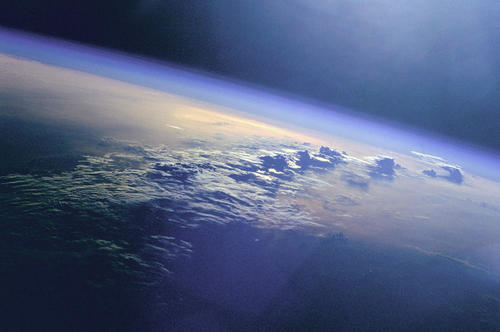Knowing What’s Going On Up There
Meteorologists at Freie Universität study how changes in the stratosphere contribute to climate change.
Mar 18, 2013
The upper limit of the stratosphere is about 50 kilometers above the Earth’s surface.
Image Credit: NASA www.nasa.gov
At least since the extreme athlete Felix Baumgartner jumped from a height of nearly 40 kilometers to the Earth, in October 2012, the entire world has known the term “stratosphere.” It is the layer of the Earth’s atmosphere at a height of between 15 and 50 kilometers above the globe, where the air is extremely thin and outer space is close at hand. Researchers in Berlin have been interested in what is going on up there since before the record-setting jump, though. The German Research Foundation (DFG) recently approved an additional 2.27 million euros for the “SHARP” research program, which deals with the topic of “Stratospheric Change and Its Role for Climate Prediction” and is being coordinated by Freie Universität Berlin. The goal is to better understand what is happening in this layer of the Earth’s atmosphere, in order to develop effective strategies for combating climate change on that basis.
The fact that the scientists leading the project are based in Berlin is only logical. Berlin is considered the cradle of research on the stratosphere, ever since meteorologist Richard Adolph Assmann, of the Aeronautical Observatory in Berlin, discovered this area of the atmosphere in 1902, at the same time as his French colleague Léon-Philippe Teisserenc de Bort. But some 60 years ago, when researchers in Berlin first found that the stratosphere was warming, hardly anyone was interested. After all, that part of the atmosphere accounts for only ten to 15 percent of the total atmospheric mass. It can’t have that big an impact on the global climate, most people probably thought at the time. Today, however, we know that when the chemical composition of the stratosphere experiences great change, that also affects conditions in the next layer down, the troposphere – the part of the Earth’s atmosphere where we live, and where most of our weather phenomena and events occur.
Climate research is now a high-tech science. Satellites long ago took the place of the rubber hot air balloon that Assmann used, over a century ago, to take measurements and collect data in the atmosphere. Today, powerful computers help the scientists to crunch data and make forecasts for the development of the climate. “To get a simulation for a period from 1960 to 2100, we have to run the computers for several months,” says meteorology professor Ulrike Langematz, who heads the SHARP research program.
Further Information
Univ.-Prof. Dr. Ulrike Langematz, Freie Universität Berlin, Department of Earth Sciences, Institute of Meteorology, Tel.: +49 30 838-71165, Email: ulrike.langematz@met.fu-berlin.de

